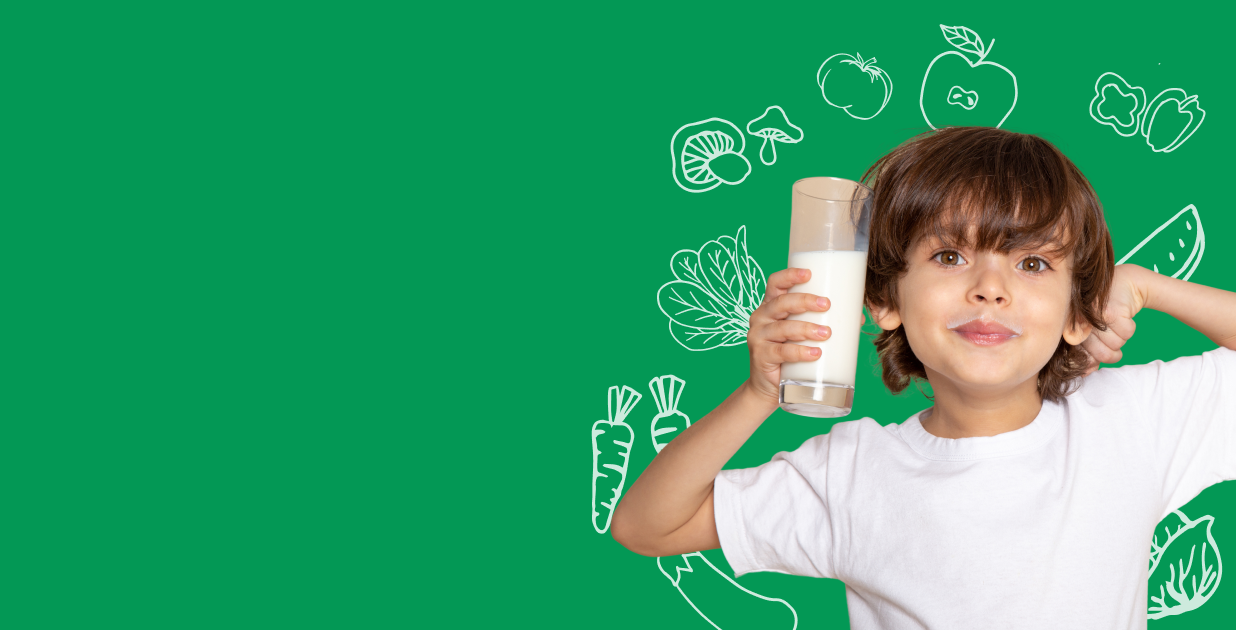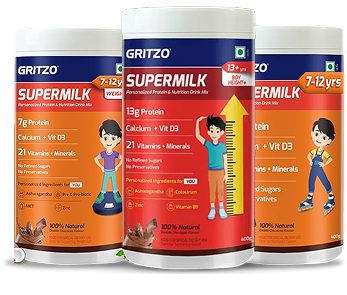The Cleanest Ingredients Your Child Deserves

Protein
Basic Building Block of our body

Growth Fuel
Your Child needs 1g protein per body weight daily, which means if your child's weight is 30kg, they need a minimum of 30g protein on a daily basis.
Proteins contain amino acids that help build and repair tissues within our bodies. Proteins help with lean muscle development, helps build strength & stamina in children.
The protein that we use in Gritzo Supermilk is a triple blend protein that combines protein from three sources that are Skimmed Milk Protein (SMP), Milk Protein Concentrate (MPC), and Whey Protein Concentrate (WPC). All of these are blended in our in-house manufacturing facilities with every batch tested for safety & quantity of protein so that what we commit on our packaging is what we deliver inside the product.
Every protein source also has something called a PDCAAS (Protein Digestibility Corrected Amino Acid Score). This score is between 0 to 1 with 0 being the lowest and 1 being the highest. A PDCAAS score of 1 means that the protein source is easily absorbed and digested by our bodies. For example, dal has a PDCAAS score of 0.5, Chana (Chickpea) have a PDCAAS of 0.8. All protein sources used in Gritzo SuperMilk has a PDCAAS score of 1 which means it scores the best in digestibility and absorption for children.
Sources of Protein From Food:

One Glass Toned Milk (250 ml)
8g

Chana (Chickpea) (100g)
19g

Paneer (100g)
18-20g
Vitamin D
Helps in the absorption of calcium

Sunshine vitamin
It is called the "sunshine vitamin" because our bodies can produce this vitamin in our skin when it is exposed to sunlight.
Over 70% indians are deficient in Vitamin D. Limited exposure to sunlight due to busy schedules & lower content of vitamin D rich foods in our daily diet has led to such a large scale deficiency. It is difficult to get vitamin D from our daily diet since it is avaiable in trace quantities in food sources.
Our bodies produce vitamin D when exposed to sunlight and it stores vitamin D in the D3 form. Hence when you are looking for supplements refrain from taking D2, always look for D3 in the ingredient list which is 3 times more efficient in increasing blood levels of Vitamin D. In Gritzo, we provide 100% of your child's daily requirement of Vitamin D3 in comparison to other brands who provide D2 (that too in lower quantities).
Vitamin D requirements varies as per the age of the kid. The details are given below:
2-6 years: 15 Mcg
7-12 years: 15 Mcg
13+ Years: 15 Mcg
Sources of Vitamin D From Food:

Egg Yolk (1 egg)
40-50 IU

Fatty fish (Salmon – 100g)
450–600 IU

Cod liver oil (1 tbsp)
1350 IU
Vitamin C
Helps to boost immunity

Immunity Antioxidant
Vitamin C reduces oxidative stress in the body, making it especially important during periods of physical exertion or mental strain like sports and exams.
Vitamin C, also known as ascorbic acid, is an essential water-soluble vitamin that the human body cannot produce or store, so it must be consumed daily through food or supplements. It is required for overall health, but especially for supporting the immune system. It also aids in iron absorption, and promoting tissue repair and collagen formation.
Vitamin C enhances immune function by stimulating the production and activity of white blood cells (like neutrophils and lymphocytes), improving the body’s ability to fight infections and reduce inflammation.
Vitamin C requirements varies as per the age of the kid. The details are given below:
1–3 years: 400 mg/day
4–8 years: 650 mg/day
9–13 years: 1,200 mg/day
14–18 years: 1,800 mg/day
Sources of Vitamin C From Food:

Amla (Indian gooseberry)
450 – 700 mg

Guava
228 mg

Oranges
50-53 mg
Vitamin B12
Helps in red blood cell formation, nerve function and energy production.

Brain & Blood Vitamins
Vitamin B12 is known as the “Energy Vitamin” because it helps convert food into energy and reduces fatigue.
Vitamin B12 is an essential water-soluble vitamin that plays a critical role in the body’s ability to produce energy.
It is required for the formation of healthy red blood cells, which transport oxygen from the lungs to all parts of the body—supporting stamina and vitality. B12 is also involved in DNA synthesis and the development of new cells, making it particularly important during periods of rapid growth in children.
Vitamin B12 helps convert carbohydrates from food into glucose, this function makes it key to supporting sustained energy levels, focus, and physical endurance in growing children.
Requirement of B12 in Children:
(1–3 years) - 0.9 µg/day
(4–8 years) -1.2 µg/day
(9–13 years) -1.8 µg/day
(14–18 years) -2.4 µg/day
Sources of Vitamin B12 from Food:

Eggs (whole)
1.1 µg

Yogurt (plain)
0.5 µg

Chicken (cooked)
0.3-0.5 µg
Magnesium
It supports bone growth, muscle function and energy production

Calming Mineral
Magnesium is often called the “calming mineral” because it supports muscle relaxation and reduces stress hormones.
Magnesium is an essential mineral involved in over 300 biochemical reactions in the body. One of its most important roles is in muscle function.
It helps muscles contract and relax properly by regulating the movement of calcium in and out of muscle cells. Calcium signals the muscle to contract, and magnesium helps it relax—maintaining balance and preventing cramps or stiffness.
About 60% of the body’s magnesium is stored in the bones, but it also circulates in muscles and soft tissues where it directly supports physical movement. This makes magnesium especially crucial during childhood, when muscles are developing and activity levels are high.
Magnesium requirements varies as per the age of the kid. The details are given below:
1–3 years - 80 mg/day
4–6 - 110 mg/day
7–9 years - 150 mg/day
Boys:
10–12 years - 220 mg/day
13–15 years - 300 mg/day
16–17 years - 340 mg/day
Girls:
10–12 years - 220 mg/day
13–15 years - 280 mg/day
16–17 years - 310 mg/day
Sources of Magnesium from Food:

Dry roasted almonds (20 Qty)
76 mg magnesium

Cooked spinach (1 cup)
87 mg magnesium

Roasted cashews (28g)
74 mg magnesium
Zinc
It is essential for cell growth & division which helps in overall growth in kids.

The Growth Mineral
Zinc is called "The Growth Mineral" for kids because it supports bone development, cell growth, and height gain during childhood and adolescence.
Zinc is an essential trace mineral required for many biological processes in the body. Though needed in small amounts, it has a big impact on growth and overall health.
It is crucial for cell division and tissue repair, making it especially important during childhood when the body is rapidly developing.
Scientifically, Zinc plays a direct role in bone growth and development by supporting the activity of bone-forming cells (osteoblasts) and promoting protein synthesis. This makes it a key nutrient for supporting healthy height and physical development in growing kids. In Gritzo Supermilk Height+ we provide with 100% RDA of Zinc so that your child gets their daily dose of this essential mineral.
Zinc requirements varies as per the age of the kid. The details are given below:
1–3 years - 5.0 mg/day
4–6 years - 6.5mg/day
7–9 years - 8.5mg/day
Boys:
0–12 years - 10.0mg/day
13–15 years - 11.0mg/day
16–17 year - 14.0mg/day
Girls:
10–12 years - 9.0mg/day
13–15 years - 9.0mg/day
16–17 years - 9.0mg/day
Sources of Zinc from Food:

Chickpeas (1 cup)
2.5 mg zinc

Lentils (1 cup)
2 mg zinc

Egg (whole) 1 large egg
0.6 mg zinc

